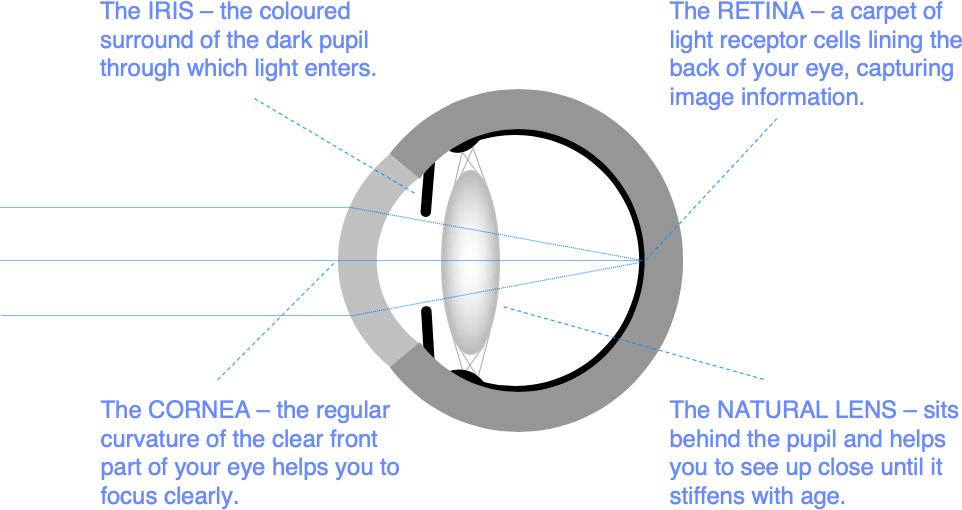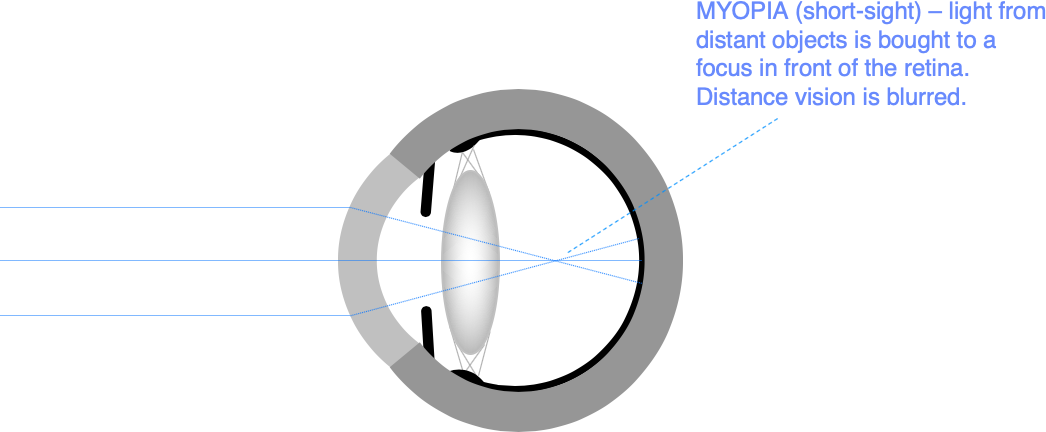You are here:
- Your Eyes / Myopia
Myopia (short-sight)
People with good eyesight are able to form a clear image of a distant object on the retina without any help from glasses or contact lenses. This is because the combined focusing power of the cornea and the lens is a good fit to the length of the eye. They have good vision for sport, are able to recognise faces easily, see the television, and drive without any help from glasses. If you are myopic, you will depend on glasses most of the time.

Myopic people have too much focusing power in their cornea and natural lens. Light from distant objects is bought to a focus in front of the retina. Negative lenses are needed to counteract the excess focusing power.

You may have good near vision. This depends on the strength of your prescription. If you are very short-sighted, you have to hold things very close to your eyes to see them clearly.

Myopia typically becomes a problem during your school years. You may recall having to sit at the front of the classroom to see the blackboard. In myopia, your spectacle prescription normally stabilises in your late teens or early-20s. It does not improve as you get older. Although some myopic people are able to read without glasses later in life, distance glasses or contact lenses will always be required, and most myopic people need bifocal or varifocal glasses by the time they get into their mid-40s.
Vision correction surgery
We normally recommend staying in daily disposable contact lenses until your prescription has been reasonably stable for 2 years before considering vision correction surgery. From your early-20s onwards, there are a range of good solutions for correcting myopia. If you have astigmatism (irregular defocus) and presbyopia (age related loss of reading vision), these problems can be treated at the same time.
We will be able to give you clear advice about which procedure would suit you best after tests at your preliminary consultation.
Here are some of the options:
- Laser vision correction – the default option for correcting myopia and astigmatism
- ICL implantation – a good solution for younger people with higher spectacle prescriptions
- RLE (lens exchange) – if you have the beginnings of cataract development in mid-life, we often recommend this approach
You can find detailed information for each of these treatments on this site under Procedures.
Preparing for your consultation
If you are a soft contact lens wearer, you should leave your contact lenses out for 3 days before your consultation. Rigid contact lenses should be left out for 2 weeks. Contact lens wear can temporarily change the surface shape of your cornea. We ask you to leave your contact lenses out to help ensure that scan information we will use to guide your treatment is as accurate as possible.
You will normally be with us for 1-2 hours to allow time for scanning, refraction testing, eye health screening and procedure advice. There is usually some waiting between stages of the consultation, so bring something to read or to listen to.
We often dilate your pupils to help examine the back of your eye. This can make driving more difficult for several hours afterwards. Parking is restricted in central London. So, we would recommend travelling to us using public transport or taxi.
The nearest tube station is OLD STREET (Northern Line).
Appointments and Enquiries
If you wish to arrange a preliminary consultation, please telephone Angelique Thomas on 020 7566 2156 or 07484 081815 (or from outside the UK +44 20 7566 2156 or +44 7484 081815) or email moorfields.ballan@nhs.net
